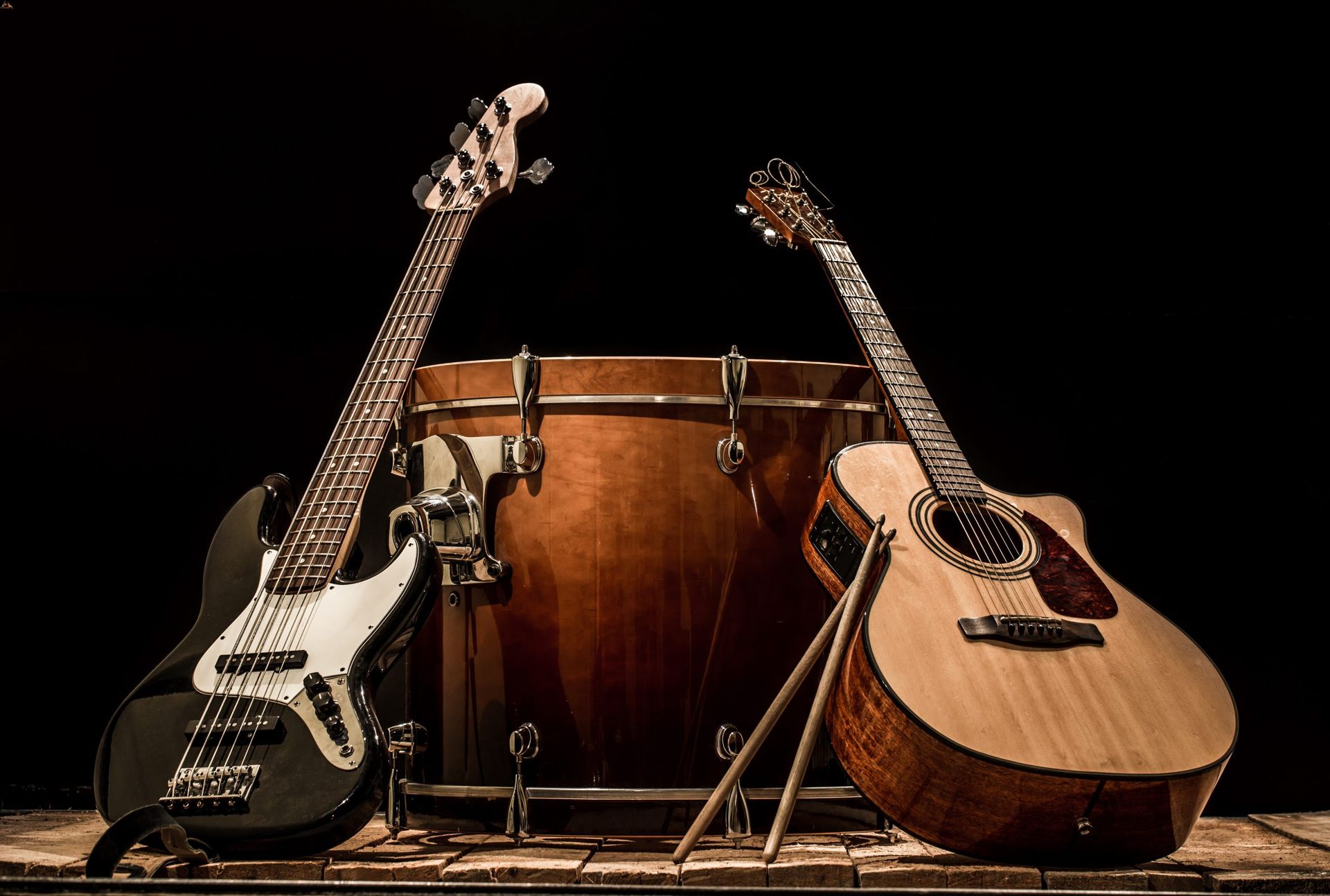Home>Instruments>Bass>What Is The Difference Between Guitar And Bass


Bass
What Is The Difference Between Guitar And Bass
Modified: February 15, 2024
Discover the key distinctions between a guitar and a bass. Understand the fundamental differences in sound, playing style, and role in a band. Explore the versatility of the bass instrument
(Many of the links in this article redirect to a specific reviewed product. Your purchase of these products through affiliate links helps to generate commission for AudioLover.com, at no extra cost. Learn more)
Table of Contents
Introduction
Music is a universal language that has the power to connect people from all walks of life. Two instruments that commonly take center stage in the world of music are the guitar and the bass. They both belong to the same family of instruments, but they have distinct differences in terms of their sound, role, and physical characteristics. Understanding these differences is crucial for aspiring musicians and enthusiasts alike.
The guitar is a versatile instrument that has been captivating audiences for centuries. It is known for its melodic range and expressive capabilities. On the other hand, the bass is a powerhouse instrument that provides the foundation and groove in a band. Together, they form the backbone of countless musical genres, from rock and pop to jazz and funk.
In this article, we will delve into the intricacies and nuances of the guitar and bass, exploring their definitions, physical differences, playing techniques, and their roles in the world of music. Whether you’re a beginner curious about the distinctions or a seasoned musician looking to expand your knowledge, this article will provide you with a comprehensive understanding of the guitar and bass.
Definition of Guitar
The guitar is a stringed musical instrument that is played by plucking or strumming its strings. It generally features a flat top, a hollow or solid body, and a neck with frets. Guitars come in various shapes and sizes, including acoustic, electric, and classical.
The standard guitar typically has six strings, although there are variations with additional strings. The strings are tuned to different pitches, allowing players to create a wide range of musical notes. The guitar’s sound is produced by the vibrations of the strings, which are transmitted to the body of the instrument and amplified through a soundhole (in the case of an acoustic guitar) or electronic pickups (in the case of an electric guitar).
Traditionally, the guitar has been associated with melodies, chords, and intricate fingerpicking patterns. It is known for its versatility in playing various musical styles, such as folk, rock, blues, and classical. Guitarists commonly use techniques like strumming, plucking, bending, sliding, and hammer-ons/pull-offs to produce unique and expressive sounds.
Over the years, the guitar has become an iconic instrument, with legendary players like Jimi Hendrix, Eric Clapton, and Jimmy Page pushing the boundaries of its capabilities. It has become a staple in bands and solo performances, captivating audiences with its melodic lines and solos.
Whether it’s a wailing electric guitar solo or a gentle acoustic accompaniment, the guitar’s popularity and versatility have solidified its status as a beloved instrument in the music world.
Definition of Bass
The bass, also known as the bass guitar or electric bass, is a stringed instrument that is similar in appearance to the guitar but differs in several key aspects. It typically features a solid body, a long neck, and four to six strings. The bass is designed to produce lower-pitched notes, providing the foundation and rhythm in a band’s sound.
The bass is tuned in the same manner as the guitar, with the strings typically tuned one octave lower. This lower tuning allows the bass to produce deep, rich tones that provide a solid groove and support the harmony of a song. The sound of the bass is amplified through magnetic pickups and played through an amplifier and speaker system.
The playing technique of the bass differs from that of the guitar. Instead of strumming chords or playing intricate melodies, bassists primarily focus on playing individual notes and creating rhythmic patterns that complement the other instruments in the band. Common techniques used on the bass include plucking (with the fingers or a pick), slapping, popping, and using techniques like slides and bends to add expression to the notes.
In a band setting, the bass is responsible for establishing the rhythm and providing a solid foundation for the other instruments. It works in conjunction with the drums to create a tight and groovy rhythm section. The bass often plays root notes, outlining the chords being played by the guitar or keyboard, but can also incorporate melodic lines and solos to add complexity and flair to the music.
The bass has played a pivotal role in various genres of music, including rock, funk, jazz, and reggae. Bassists like Jaco Pastorius, Flea, and John Entwistle have pushed the boundaries of the instrument, showcasing its dynamic range and melodic capabilities. In addition to its role in bands, the bass is also a popular instrument for solo performances, with bassists incorporating looping and effects to create rich and layered compositions.
Whether it’s grooving along with a band or taking center stage with a solo, the bass brings depth, rhythm, and soul to the music, cementing its status as an indispensable instrument in the world of music.
Physical Differences
While the guitar and bass may share some similarities in terms of their general appearance and construction, there are distinct physical differences that set them apart.
First and foremost, the size and shape of the instruments vary. Guitars often come in a variety of shapes such as the classic hourglass-shaped acoustic guitar or the sleek and streamlined electric guitar. The bass, on the other hand, typically has a larger body with a longer neck to accommodate the lower-pitched strings. The size difference is mainly due to the need to produce deeper, resonant tones on the bass.
Another key difference lies in the number of strings. While the standard guitar has six strings, bass guitars commonly have four strings. However, there are also five-string and six-string bass guitars available, offering extended range options for bassists who require additional low or high notes.
String gauge is another factor that sets the guitar and bass apart. Bass strings are thicker and heavier compared to guitar strings. The thicker strings allow for producing the lower frequencies required for the bass’s deep, resonant sound. The tension of the strings also differs, with bass strings requiring more tension to maintain proper intonation and sound quality.
The playing technique also contributes to the physical differences between the guitar and bass. Guitarists typically play using a combination of pick and fingers, whereas bassists primarily use their fingers to pluck the strings. This difference is due to the need for more precision and control in producing the lower-pitched and rhythmically precise notes of the bass.
Overall, while the guitar and bass share some physical similarities, such as their general structure and stringed nature, their size, number of strings, string gauge, and playing techniques differ significantly. These physical differences between the two instruments contribute to the unique sounds and roles they play in the musical landscape.
Number of Strings
The number of strings is one of the key distinctions between the guitar and bass. While guitars typically have six strings, bass guitars commonly have four strings. However, it is worth noting that there are variations of both instruments with different string configurations.
The six-string guitar is the most common and widely recognized variation. The strings on a guitar are typically tuned to E, A, D, G, B, and E, starting from the thickest string to the thinnest. This configuration allows guitarists to play a wide range of melodies, chords, and harmonies, providing a rich and versatile tonal palette.
On the other hand, bass guitars traditionally have four strings, tuned to E, A, D, and G. The strings on a bass are thicker and produce lower-pitched sounds compared to the guitar. The four-string configuration is ideal for providing a solid foundation and rhythmic support in a band, as it focuses on anchoring the low end of the sonic spectrum.
However, in recent years, bass guitars with five, six, and even more strings have gained popularity. These extended-range basses add additional low or high notes to the instrument’s range, providing more flexibility and expanding the bassist’s tonal options. The additional strings are typically tuned in fourths or fifths, allowing for greater range and access to more notes without having to shift positions on the neck as frequently.
While basses with five or more strings are frequently used in genres such as metal and progressive rock, four-string basses remain the standard and are widely used across various musical genres.
Ultimately, the number of strings on the guitar and bass is a defining characteristic that influences the tonal capabilities and playing styles of these instruments. Whether it’s the melodic versatility of the six-string guitar or the powerful low-end foundation of the four-string bass, both instruments offer unique musical possibilities.
Sound Range
The sound range is another important factor that distinguishes the guitar and bass. While both instruments belong to the same family of stringed instruments, they offer different sonic characteristics due to their pitch ranges.
The guitar is known for its wide sound range, capable of producing both high-pitched melodies and lower-pitched chords. With its six strings, the guitar spans a broad frequency spectrum, allowing for the execution of intricate melodies, harmonies, and solos. The higher-pitched strings are ideal for playing melodies and lead lines, while the lower-pitched strings provide a rich foundation for chords and rhythm playing.
On the other hand, the bass focuses on the lower end of the frequency spectrum, providing a solid and deep foundation to the music. The bass guitar produces low-pitched sounds that add weight, groove, and energy to a song. Its strings are tuned to lower frequencies, allowing bassists to create rhythmic patterns and root notes that support the harmonies and melodies of the other instruments in the band.
With its lower range, the bass guitar forms a crucial part of a band’s rhythm section, working in tandem with the drums to create a tight and driving groove. The deep and resonant tones produced by the bass add warmth and depth to the overall sound, giving the music a solid backbone.
While the guitar’s sound range allows for greater melodic and harmonic complexity, the bass excels in creating a solid rhythmic foundation, enhancing the dynamics and energy of a song.
It’s important to note that the sound range of both instruments can be further expanded and modified through the use of various playing techniques, effects pedals, and amplification. Guitarists and bassists can explore different techniques such as bends, slides, palm muting, or utilizing effects like distortion or delay to create a wide range of tonal variations.
Ultimately, the sound ranges of the guitar and bass complement each other, enabling musicians to create captivating and dynamic musical arrangements. Whether it’s the soaring melodies of the guitar or the deep grooves of the bass, both instruments contribute to the overall sonic landscape of a song.
Playing Technique
The guitar and bass differ not only in their sound and physical characteristics but also in their playing techniques. These techniques contribute to the unique styles and roles played by each instrument in the musical realm.
Guitarists employ a variety of techniques to produce their desired sounds. The most common approach is strumming, which involves using a pick or fingers to brush or strike across the strings. This technique allows guitarists to play chords, arpeggios, and rhythm patterns. Fingerpicking is another popular technique that involves plucking the strings with the fingers, enabling more intricate and melodic playing.
Guitarists also utilize techniques such as bending, sliding, and hammer-ons/pull-offs to add expression and embellish their playing. Bending involves pushing or pulling a string sideways to change its pitch, creating a vocal-like effect. Sliding entails smoothly transitioning from one note to another by rapidly moving a finger up or down the fretboard. Hammer-ons and pull-offs are techniques where the player uses their fretting hand to sound notes without re-plucking the string, creating rapid and fluid passages.
On the other hand, bassists have a distinct playing technique that focuses on providing a solid rhythmic and harmonic foundation. Bassists typically use their fingers (known as fingerstyle) to pluck the strings, creating a full and rounded tone. This technique allows for greater control over dynamics and articulation, especially when playing intricate bass lines or walking bass patterns.
In addition to fingerstyle, many bassists employ the technique of slapping and popping. Slapping involves striking the strings with the thumb, creating a percussive sound, while popping involves using the thumb or fingers to snap the strings, producing a sharp and distinctive attack. These techniques can add a funky and rhythmic flavor to the basslines and are commonly used in genres such as funk, R&B, and slap-style bass playing.
Both guitarists and bassists can further explore advanced techniques such as tapping, sweep-picking, and harmonics to expand their playing abilities and create unique sounds.
Regardless of the instrument, mastering the techniques requires practice, patience, and a deep understanding of musical concepts. The guitar’s versatile playing techniques allow for melodic expression and chordal accompaniment, while the bass’s focus on rhythm and groove creates a solid foundation for the music.
It’s important to note that individual playing styles and techniques can greatly vary among guitarists and bassists, contributing to the diversity and richness of their musical expression.
Role in Music
The guitar and bass play distinct roles in the world of music, contributing to the overall sound and texture of a song. Understanding these roles helps musicians and music enthusiasts appreciate the unique contributions of each instrument.
The guitar is often considered a versatile instrument, capable of playing lead melodies, chords, and intricate arpeggios. It is commonly used to provide both rhythm and melody in a musical arrangement. In a band context, the guitar often takes on the role of the lead instrument, crafting catchy and memorable riffs, solos, and melodic lines that drive the song forward. The guitar is also responsible for providing harmonic support by playing chords and arpeggios, creating the harmonies that underpin the music.
On the other hand, the bass is primarily responsible for providing the foundation and rhythm in a band’s sound. The bass lays down the low-end frequencies, creating a solid and driving groove that supports the other instruments. By playing root notes of chords and connecting them with rhythmic patterns, the bass keeps the music grounded and helps establish the overall structure of a song. It interacts closely with the drums, forming the rhythmic backbone of the music and ensuring a tight and cohesive sound.
The bass’s role extends beyond providing a rhythmic foundation; it also enhances the harmonic and melodic aspects of a song. Bassists have the freedom to incorporate melodic lines, fills, and solos that add complexity and depth to the music. These melodic lines can complement and interact with the other instruments, creating an intricate interplay within the band.
In certain genres, such as funk, R&B, and jazz, the bass takes on a more pronounced and prominent role, often delivering intricate and melodic basslines that become signature elements of the music. These genres heavily rely on the rhythmic and grooving elements provided by the bass, pushing it to the forefront of the musical arrangements.
Both the guitar and bass contribute to the overall composition and sonic landscape of a song. While the guitar provides melody, harmony, and rhythmic accompaniment, the bass adds depth, rhythm, and groove. Their synergy is essential in creating a well-balanced and captivating musical experience.
It’s important to note that the roles of the guitar and bass can vary depending on the musical genre and the specific artistic vision of the musicians. Some genres may showcase the guitar more prominently, while others may allow the bass to shine. Regardless, the guitar and bass work harmoniously together, playing off each other’s strengths to create a cohesive and compelling musical tapestry.
Popularity and Cultural Significance
The guitar and bass have both achieved significant popularity and cultural significance throughout the history of modern music. These instruments have played a pivotal role in shaping various genres and have become iconic symbols of musical expression.
The guitar, due to its versatility and widespread appeal, has amassed a huge following worldwide. It has been a staple instrument in popular music genres such as rock, blues, country, and pop. The guitar has been prominently featured in countless hit songs, with its melodic solos and infectious riffs becoming instantly recognizable to music fans everywhere.
Beyond its musical impact, the guitar has become a cultural symbol. It is often associated with rebellion, individuality, and freedom of expression. Think of the iconic images of rock legends like Jimi Hendrix and Eddie Van Halen, wielding their guitars on stage, captivating audiences with their electrifying performances. The guitar has a sense of coolness and charisma that has transcended generations, making it an instrument of aspiration for aspiring musicians and fans alike.
The bass, although often playing a more supporting role, has an equally significant impact on music. In genres such as funk, reggae, and jazz, the bassline takes center stage, driving the rhythm and grooves. Bassists like Bootsy Collins, Aston Barrett, and Jaco Pastorius have elevated the instrument to new heights, showcasing its melodic capabilities, virtuosity, and the inherent power of the bass sound.
The bass also holds cultural significance in popular music. It has influenced the way people move and dance, as its deep, pulsating tones resonate within the body and create a physical connection to the music. The bassline often forms the backbone of dance-oriented genres, encouraging people to move and feel the rhythm in their bones.
Both the guitar and bass have become more than just instruments; they have become cultural touchstones, associated with memorable songs and moments in music history. The guitar hero archetype, with its emphasis on technical skill and showmanship, has inspired countless individuals to pick up the instrument and pursue their musical dreams. Likewise, the bass has played a vital role in shaping the sonic landscape of popular music, inspiring generations of bassists to explore the instrument’s expressive possibilities.
Whether it’s the searing guitar solos that ignite the spirit or the driving basslines that shake the foundation, both instruments have left an indelible mark on the world of music.
Conclusion
In conclusion, the guitar and bass are two distinct yet interconnected instruments that have captivated musicians and audiences alike. They have unique characteristics in terms of their sound, physical attributes, playing techniques, roles in music, and cultural significance.
The guitar, with its versatile sound range and melodic capabilities, has become a symbol of musical expression and individuality. It provides both melody and harmony, and its captivating solos and chords have become integral parts of countless songs across various genres.
The bass, on the other hand, focuses on providing a solid rhythmic foundation with its deep, resonant tones. Its driving basslines and rhythmic patterns create the groove and energy that propel the music forward. The bass adds depth to the overall sound, allowing for a full and vibrant musical experience.
Both instruments have their own set of playing techniques, allowing musicians to explore various styles and genres. From the intricate fingerpicking of the guitar to the rhythmic fingerstyle of the bass, the techniques employed by players enhance the distinct characteristics of each instrument.
Moreover, the guitar and bass have achieved significant popularity and cultural significance. They have become symbols of rebellion, individuality, and artistic expression. The guitar, in particular, is often associated with the image of the rockstar, while the bass drives the rhythm and grooves that get people moving.
Ultimately, the guitar and bass are integral components of the musical landscape, working together to create captivating and memorable compositions. Whether it’s the guitar’s soaring melodies or the bass’s deep, resonant grooves, both instruments have left an indelible mark on the world of music, inspiring generations of musicians and shaping the soundscape of popular music.
So, whether you’re strumming a guitar or laying down a solid bassline, embrace the magic and power of these instruments and let your creativity soar!











